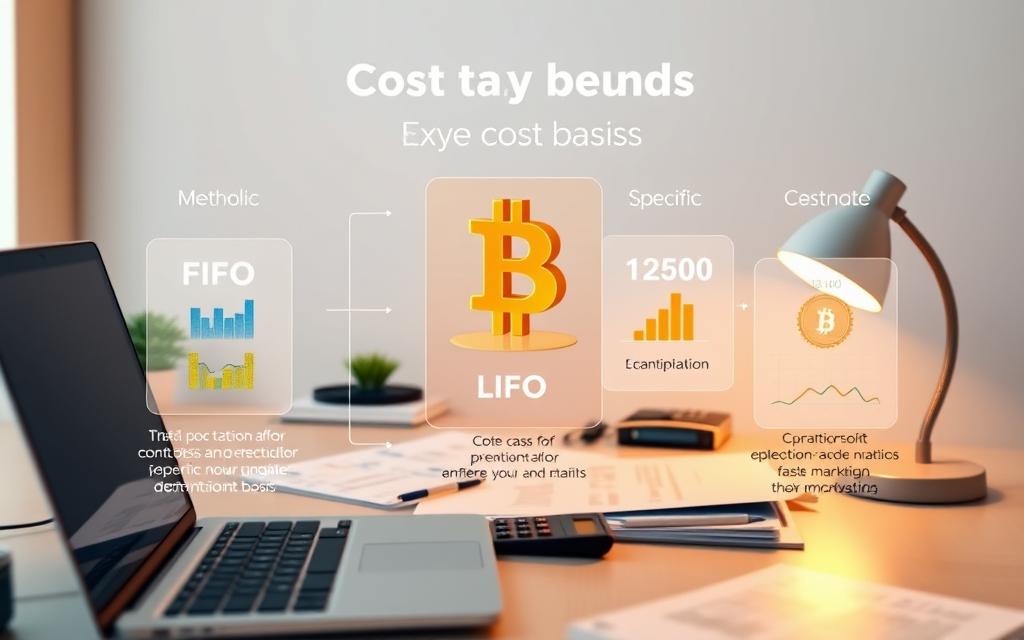Table of Contents
The IRS classifies digital assets as property, meaning transactions trigger tax obligations. Whether trading, selling, or spending, each action may have tax implications. Understanding these rules helps avoid costly mistakes.
Short-term gains face rates up to 37%, while long-term holdings cap at 20%. Mining and staking rewards count as ordinary earnings. Proper record-keeping ensures accurate reporting.
New 2025 regulations mandate wallet-level cost tracking. Penalties for errors reach $250,000. Specialized software simplifies compliance with forms like 1099-DA and Schedule 1.
Key takeaway: Every transaction matters. Strategic planning minimizes liabilities while staying compliant.
How the IRS Classifies Cryptocurrency
The U.S. tax authority treats digital coins like physical assets, not traditional currency. This classification means every trade, sale, or purchase can create tax obligations. Rules differ based on how you acquire and use these holdings.
Cryptocurrency as Property: Tax Implications
Since 2014, the IRS has considered virtual coins property under tax law. This triggers capital gains rules when disposing of them. Even swapping one token for another counts as a taxable event.
Key differences from traditional investments:
- Wallet transfers between your own accounts aren’t taxed
- Spending coins for goods creates potential gains/losses
- Mining rewards get valued at fair market rates when received
Convertible Virtual Currency vs. Real Money
Only tokens functioning as payment methods (like Bitcoin) follow these rules. The IRS calls them “convertible virtual currency.” Non-tradable digital items like game tokens have different treatment.
Major distinctions:
| Feature | Convertible Crypto | Traditional Money |
|---|---|---|
| Tax Treatment | Property rules apply | Currency rules apply |
| Record-Keeping | Cost basis tracking required | Only transactions over $10k reported |
| Reporting Forms | Form 8949 + Schedule D | Form 1040 for interest |
Pro tip: Business miners report earnings as ordinary income, while hobbyists may face different rules. Proper classification matters for income tax purposes.
Is Cryptocurrency Taxable Income? Key IRS Rules
Tax obligations vary depending on how you use virtual coins. The IRS divides profits into two categories: short-term (held under one year) and long-term. Each type faces different rates and reporting requirements.
Capital Gains vs. Ordinary Income
Short-term gains (under 12 months) match your ordinary income tax bracket—ranging from 10% to 37% in 2024. Long-term holdings qualify for lower rates (0%-20%).
“Disposing of digital assets, including trades or sales, counts as a taxable event.” — IRS Notice 2014-21
Taxable vs. Non-Taxable Transactions
Not all actions trigger liabilities. Examples of non-taxable events:
- Transferring coins between your own wallets
- Donating to registered charities
- Receiving gifts under $16,000 (2024 limit)
However, swapping tokens or selling for fiat always creates gains or losses. *Pro tip*: Track dates meticulously—errors can lead to audits.
When Cryptocurrency Triggers a Taxable Event
Certain transactions with digital assets automatically create tax liabilities under IRS rules. These events often involve exchanging, selling, or earning virtual coins. Recognizing them ensures accurate reporting and avoids penalties.
Selling for Fiat or Goods
Converting digital coins to cash or goods services counts as a disposal. For example, using $38,500 in BTC to buy a car creates a capital gain or loss. Merchants must report such payments as business earnings.
Step-by-step calculation:
- Subtract the original cost (e.g., $6,000) from the sale value ($8,000).
- The $2,000 profit is taxable as short- or long-term gain.
Trading One Token for Another
Swapping Bitcoin for Ethereum triggers taxes, even without cashing out. The IRS treats this like selling property. DeFi swaps follow the same rules—fair market value at swap time determines the tax impact.
Note: Like-kind exchanges (e.g., real estate) no longer apply to digital assets after 2017.
Receiving Payments or Rewards
Staking rewards, airdrops, and salary paid in crypto are taxable when received. Employers report wages on W-2 forms, while freelancers use Schedule C. Hard forks require reporting new coins at fair market value.
“NFT purchases using virtual coins are taxable events. Track the USD equivalent at transaction time.” — IRS FAQ
How Cryptocurrency Taxes Work in the US
Tax rates on virtual assets depend on holding periods and filing status. The IRS treats profits differently based on whether you held coins for under or over one year. Proper classification maximizes savings and avoids audits.
Short-Term vs. Long-Term Capital Gains
Assets sold within 365 days face short-term rates matching ordinary income brackets. For 2024, these range from 10% to 37%. Holdings beyond a year qualify for reduced long-term rates (0%-20%).
Example: A single filer earning $100,000 pays 24% on short-term gains but only 15% for long-term.
Tax Rates Based on Income and Holding Period
Your bracket depends on marital status and total earnings. The 3.8% Net Investment Income Tax (NIIT) may apply to high earners.
| Filing Status | 2024 Long-Term Rate (0%) | 2024 Long-Term Rate (15%) | 2024 Long-Term Rate (20%) |
|---|---|---|---|
| Single | Up to $44,625 | $44,626–$492,300 | Over $492,300 |
| Married Jointly | Up to $89,250 | $89,251–$553,850 | Over $553,850 |
Pro tips to reduce liabilities:
- Tax-loss harvesting: Offset gains by selling underperforming assets.
- Crypto IRAs: Defer taxes with retirement accounts.
- State planning: Texas (0%) vs. California (13.3%) rates vary widely.
“Hold assets 366 days to qualify for long-term rates. Track dates with a countdown clock tool.” — IRS Publication 550
Types of Cryptocurrency Tax Events
Digital asset activities trigger specific tax events under IRS guidelines. From earning to spending, each action may require reporting. Proper categorization ensures compliance and avoids penalties.
Mining and Staking Rewards
Mining rewards count as ordinary income at fair market value when received. The IRS requires reporting earnings over $600 on Form 1099-MISC. Validators can deduct operational costs like hardware depreciation.
Pro tip: Pool miners must track individual payouts. Business miners report earnings differently than hobbyists.
Airdrops and Hard Forks
Unrequested airdrops are taxed as income based on their value at receipt. Chain splits (e.g., Bitcoin Cash) create new taxable assets. Protocol upgrades without new coins typically don’t trigger taxes.
Using Crypto for Purchases
Spending coins for goods or services counts as a disposal. Gift card purchases follow the same rules. Lost coins require documentation for potential deductions.
| Event | Taxable? | Reporting Form |
|---|---|---|
| Mining rewards | Yes (Income) | 1099-MISC |
| Airdrops | Yes (Income) | Schedule 1 |
| Retail purchases | Yes (Capital Gain) | Form 8949 |
| Wallet transfers | No | None |
“Burn transactions may qualify as disposals if they remove coins from circulation permanently.” — IRS Memo 2023-05
Calculating Cryptocurrency Gains and Losses
Tax strategies hinge on correctly valuing each transaction. Miscalculations lead to overpayment or penalties. Follow these steps to ensure accuracy.
Determining Cost Basis and Fair Market Value
Cost basis includes purchase price plus fees. Blockchain explorers verify transaction dates and amounts. Historical price APIs (e.g., CoinGecko) provide USD values at execution time.
For inherited assets, basis resets to market value at the owner’s death. Margin trades require separate tracking of interest and principal.

FIFO, LIFO, and HIFO Methods
The IRS defaults to FIFO (First-In-First-Out) unless specified otherwise. Alternative methods like HIFO (Highest-In-First-Out) can lower taxes by selling high-basis lots first.
| Method | How It Works | Best For |
|---|---|---|
| FIFO | Sells oldest assets first | Long-term holders |
| LIFO | Sells newest assets first | Short-term traders |
| HIFO | Sells highest-cost assets first | Tax minimization |
HIFO example: Selling ETH bought at $50,000 (basis) for $15,000 creates a $35,000 loss to offset gains.
- Specific identification: Must document lot selection before selling.
- Software tools: CoinLedger auto-calculates HIFO savings; Koinly supports multi-method comparisons.
- Form 8949: List each sale’s date, proceeds, and basis in Columns A–E.
“Futures contracts follow Section 1256 rules—60% long-term rates apply regardless of holding period.” — IRS Publication 550
Reporting Cryptocurrency on Your Taxes
Accurate tax reporting for digital assets requires specific IRS forms and documentation. The process varies based on transaction types and holding periods. Proper filing avoids audits and penalties.
Form 8949 and Schedule 1
Form 8949 details capital gains or losses from sales or trades. List each transaction’s date, proceeds, and cost basis. Match totals to Schedule D for final calculations.
Key steps:
- Reconcile with exchange-provided 1099s
- Separate short-term vs. long-term holdings
- Report DeFi swaps using fair market values
Form 1099-DA (2025 Update)
Starting in 2025, brokers must issue Form 1099-DA for digital asset transactions. This includes wallet addresses and cost basis tracking. Non-compliant exchanges face penalties.
| Form | Purpose | Deadline |
|---|---|---|
| Form 8949 | Capital gains reporting | April 15 |
| Schedule 1 | Additional income (e.g., staking) | April 15 |
| 1099-DA | Broker-reported transactions | January 31 |
“Amended returns (Form 1040-X) require original documentation. Keep records for 7 years post-filing.” — IRS Notice 2023-34
Pro tips:
- Use tax software to auto-populate forms
- Hire a crypto-specific CPA for complex cases
- Retain wallet statements and API logs
Cryptocurrency Mining and Taxation
The IRS treats mining rewards as ordinary earnings, not capital gains. Miners must report the fair market value of coins when received. How you report depends on whether mining is a business or hobby.
Income Tax on Mining Rewards
Mining pools issue Form 1099-NEC for earnings over $600. Self-employed miners pay 15.3% self-employment tax plus income tax. Hobbyists report rewards on Schedule 1 without deducting expenses.
Key reporting differences:
- Business miners: File Schedule C, deduct hardware and electricity
- Hobby miners: No deductions allowed under hobby loss rules
- Cloud mining: Contracts taxed as ordinary income
Business vs. Hobby Mining
The IRS considers mining a business if done for profit with regularity. Five factors determine status:
- Profit motive and business plan
- Time spent mining weekly
- Separate bank accounts
- State licensing compliance
- Equipment depreciation claims
Pro tip: Business miners can write off ASIC hardware over 5 years using MACRS. Renewable energy credits may apply for solar-powered rigs.
“Home office deductions require exclusive, regular use of space for mining operations.” — IRS Publication 587
Staking Rewards: Tax Treatment
Earning digital assets through staking creates immediate tax obligations under IRS guidelines. Rewards count as ordinary income at fair market value when received. Subsequent sales trigger capital gains based on price changes.
How Staking Income Is Valued
The IRS requires reporting rewards when they’re under your control. Validators and delegators must track:
- Proof-of-Stake vs. Delegated Proof-of-Stake: Different reward structures affect timing.
- Liquid staking (e.g., Lido) taxes rewards immediately; illiquid locks defer until unstaking.
- Cross-chain rewards (e.g., Cosmos to Osmosis) use USD value at receipt.
| Valuation Method | When Taxed | Example |
|---|---|---|
| Daily Accrual | Each reward epoch | Ethereum 2.0 |
| Upon Claim | When withdrawn | Cardano’s ADA |
| Auto-Compounding | When reinvested | Avalanche pools |
“Staking rewards are taxable in the year you gain dominion and control over them.” — IRS Memo 2023-12
Capital Gains When Selling Staked Crypto
Disposing of staked assets creates a second tax layer. Key considerations:
- Cost basis equals the reward’s value when taxed as income.
- Holding periods reset at sale—short-term if under 12 months.
- Slashing penalties may qualify as capital losses.
Pro tip: Use specific identification to sell high-basis lots first, reducing gains.
Cryptocurrency Gifts and Donations
Gifting digital assets involves unique tax considerations under IRS rules. Proper planning maximizes benefits while staying compliant. Both personal transfers and charitable contributions have specific reporting requirements.

Annual Exclusion Limits for Gifts
The IRS allows tax-free transfers up to $18,000 per recipient annually (2024). This applies to virtual assets valued at fair market price when gifted. Amounts above this trigger gift tax reporting.
Key strategies for larger transfers:
- Gift splitting: Married couples combine allowances for $36,000 per recipient
- Step-up basis: Inherited assets reset cost basis to date-of-death value
- Education/medical payments: Unlimited if paid directly to institutions
“Form 709 must file for gifts exceeding $18,000. Include wallet addresses and transaction hashes.” — IRS Form 709 Instructions
Charitable Contribution Benefits
Donating virtual coins to 501(c)(3) organizations avoids capital gains taxes. The deduction equals the asset’s fair market value on transfer date. Major charities now accept digital assets directly.
| Consideration | Personal Gifts | Charitable Donations |
|---|---|---|
| Tax Form | Form 709 (if >$18k) | Schedule A |
| Valuation | Date of transfer | Date of donation |
| Limit | $18k/person/year | 60% AGI for cash donations |
| Appraisal | Not required | Needed for gifts >$5,000 |
Pro tips for maximum impact:
- Verify charity wallet addresses through official websites
- Use donor-advised funds for anonymous giving
- Document all transactions with timestamped screenshots
New Crypto Tax Rules for 2025
Starting January 2025, digital asset holders face significant changes in tax reporting requirements. The IRS mandates wallet-level cost basis tracking for all virtual asset transactions. These updates aim to standardize reporting across exchanges and self-custody solutions.
Wallet-Based Cost Basis Tracking
Investors must now maintain detailed records showing acquisition dates and prices for each wallet. The new system groups assets by digital storage locations rather than treating all holdings as a single pool.
Key implementation challenges:
- Non-custodial wallets: Self-hosted solutions require manual entry of historical data
- Multisig accounts: Shared control complicates ownership attribution
- Privacy tools: Mixers and anonymizers may trigger additional scrutiny
“Taxpayers may use FIFO, LIFO, or specific identification methods—but must apply them consistently across wallet groups.” — IRS Notice 2024-18
Deadlines and Compliance Requirements
All 2025 transactions require wallet-level tracking starting January 1. The IRS provides transition relief for legacy systems through June 30, 2025.
| Requirement | Deadline | Form |
|---|---|---|
| Wallet grouping election | March 15, 2025 | 8949-W |
| 1099-DA filing | January 31, 2026 | 1099-DA |
| Basis reconciliation | April 15, 2026 | Schedule D-2 |
Broker definition expands to include:
- Decentralized exchanges with fiat gateways
- Payment processors handling >200 transactions/year
- Staking pool operators distributing rewards
Pro tip: Use IRS-approved software to automate wallet grouping. Penalty relief applies for good-faith compliance efforts during the transition year.
Penalties for Not Reporting Crypto Taxes
Failure to report digital asset transactions can lead to severe IRS consequences. Authorities actively pursue non-filers through blockchain analysis tools. Civil and criminal penalties apply depending on violation severity.

IRS Audits and Fines
The agency prioritizes virtual currency audits due to high non-compliance rates. Civil fines start at $250 per missed transaction, capping at $250,000 annually. Criminal charges may apply for willful evasion.
Three-tier penalty system:
- Negligence: 20% of underpaid tax plus interest
- Substantial understatement: Additional 20% penalty
- Fraud: 75% of owed tax with possible imprisonment
“Offshore holdings require FBAR filings if aggregate balances exceed $10,000 at any point.” — FinCEN Guidance 2024
How to Amend Past Returns
Taxpayers can amend filings using Form 1040-X within three years. The Voluntary Disclosure Program helps reduce penalties for late filers. Essential documentation includes:
- Wallet statements showing historical balances
- Exchange records with timestamps
- Calculations of adjusted cost basis
Pro tip: State agencies often mirror federal enforcement. California imposes extra 20% penalties for crypto underreporting.
| Situation | Defense Strategy |
|---|---|
| First-time offense | Penalty abatement request |
| Complex transactions | CPA affidavit |
| Foreign reporting | Streamlined compliance procedure |
Strategies to Minimize Crypto Taxes
Smart tax planning can significantly reduce liabilities on digital asset transactions. Legal methods exist to optimize outcomes while maintaining full compliance. These approaches leverage timing, asset classification, and IRS provisions.
Tax-Loss Harvesting Techniques
Tax-loss harvesting involves selling underperforming assets to offset gains. The IRS allows deducting up to $3,000 in net losses annually. This strategy works best when paired with careful timing.
Key considerations:
- The wash sale rule doesn’t currently apply to digital assets (unlike stocks)
- Token pairing creates intentional losses to neutralize gains in similar assets
- Document all transactions with timestamps and wallet addresses
“Harvest losses quarterly to maintain flexibility. December sales often create the most impact.” — IRS Publication 550
Long-Term Holding Advantages
Assets held over 365 days qualify for reduced rates. Single filers earning under $47,025 (2024) pay 0% on long-term gains. This creates substantial savings versus short-term holding periods.
| Strategy | Benefit | Consideration |
|---|---|---|
| Donor-advised funds | Avoid capital gains while donating | Minimum $5,000 contribution |
| Opportunity zones | Defer taxes for 5-10 years | Must invest within 180 days |
| Crypto IRAs | Contribute up to $7,000 annually | Early withdrawal penalties apply |
Additional strategies for high-net-worth individuals:
- Charitable remainder trusts provide lifetime income streams
- Entity formation separates personal and business holdings
- Installment sales spread tax burdens across multiple years
Pro tip: Cross-border planning may leverage lower international rates. Always consult a specialist for complex cases.
Common Cryptocurrency Tax Mistakes
Over one-third of digital asset holders make costly filing mistakes annually. The IRS increasingly flags small errors through blockchain analysis tools. Even minor oversights can snowball into major liabilities during audits.

Ignoring Small Transactions
Many investors wrongly assume micro-transactions fall under reporting thresholds. Every trade, including gas fee payments and airdrops, creates a taxable event. Example: Forgetting to report 50 small ETH swaps could trigger $12,500 in penalties.
Critical areas taxpayers overlook:
- DeFi interactions: Liquidity pool entries/exits count as disposals
- Stablecoin conversions: USD-to-USDT trades still require reporting
- NFT activities: Minting fees and royalties both have tax implications
Miscalculating Cost Basis
Incorrect cost basis tracking causes 42% of underpayment cases according to IRS data. Many platforms only provide partial acquisition data, leading to miscalculating gains.
| Error Type | Solution |
|---|---|
| Missing fee inclusion | Add network costs to basis calculations |
| Wrong valuation method | Consistently apply FIFO or HIFO |
| Lost wallet assets | Document with blockchain explorers |
“Treat every wallet activity as potentially taxable—even internal transfers between your own addresses.” — IRS Memo 2023-27
Smart strategies to avoid mistakes:
- Use IRS-approved tracking software
- Reconcile exchange records monthly
- Consult professionals for complex cases
Tools to Simplify Crypto Tax Reporting
Tax season stress fades when using purpose-built crypto solutions. The right tools automate calculations while ensuring IRS compliance. Both DIY software and professional services handle complex tracking needs.
Best Crypto Tax Software
Leading platforms like CoinTracker and Koinly support 300+ exchanges. These solutions offer distinct advantages for different user needs:
- Import options: API connections sync live data, while CSV uploads work for historical records
- Audit protection: Generate IRS-ready reports with transaction-level documentation
- DeFi integration: Automatically classify liquidity pool entries and yield farming rewards
Advanced features include NFT valuation tools and tax form previews. International reporting handles multiple currencies and tax jurisdictions.
| Feature | CoinLedger | Koinly |
|---|---|---|
| Cost Basis Methods | 6 including HIFO | 4 including LIFO |
| DeFi Support | 150+ protocols | 200+ protocols |
| Tax Form Output | 8949, Schedule D | International formats |
Working with a Tax Professional
Certified tax professionals with CIFT credentials provide personalized guidance. They help navigate complex situations like proof-of-reserve documentation and multi-state filings.
When interviewing specialists:
- Verify experience with blockchain analysis tools
- Ask about contingency fee structures
- Request sample client reports
“A qualified CPA saves 3x their fee in optimized tax strategies and audit protection.” — National Association of Tax Professionals
For advanced planning, explore capital gains minimization strategies used by experienced investors.
Conclusion
Navigating digital asset taxes requires staying updated on evolving regulations. The 2025 wallet-tracking mandate demands careful record-keeping for all transactions.
Consulting a tax professional saves time and reduces audit risks. State laws vary—California imposes higher rates than Texas.
Remember quarterly estimated payments if expecting gains over $1,000. Emerging technologies like CBDCs may bring new reporting rules.
Pro tip: Bookmark IRS.gov/crypto for official updates. Stay compliant while maximizing legal savings.
FAQ
How does the IRS classify cryptocurrency for tax purposes?
The IRS treats digital assets as property, meaning they are subject to capital gains taxes when sold or exchanged. This includes Bitcoin, Ethereum, and other altcoins.
Are crypto-to-crypto trades taxable?
Yes, swapping one digital asset for another triggers a taxable event. You must report gains or losses based on fair market value at the time of the trade.
Do I owe taxes on staking rewards?
Staking income is considered ordinary earnings in the year received. When you later sell those rewards, capital gains rules apply to any price appreciation.
What forms are required for crypto tax reporting?
Most investors use Form 8949 with Schedule D. Starting in 2025, exchanges must issue Form 1099-DA for certain transactions.
Can I deduct crypto losses on my taxes?
Capital losses from sales can offset gains. If losses exceed gains, you may deduct up to ,000 annually against other income.
How is mining income taxed?
Mined coins count as ordinary income at their fair market value when received. Business miners report on Schedule C, while hobbyists use Schedule 1.
What’s the difference between short-term and long-term capital gains?
Assets held under one year face ordinary income rates (10-37%). Those held longer qualify for preferential rates (0-20%).
Are crypto gifts taxable?
Gifts under ,000 per recipient (2024) aren’t taxed. The recipient inherits your cost basis for future sales.
What happens if I don’t report crypto transactions?
The IRS may impose penalties up to 75% of unpaid tax plus interest. Deliberate avoidance could lead to criminal charges.
How can I reduce my crypto tax bill?
Strategies include tax-loss harvesting, holding assets long-term, and donating appreciated coins to charity for fair market value deductions.









